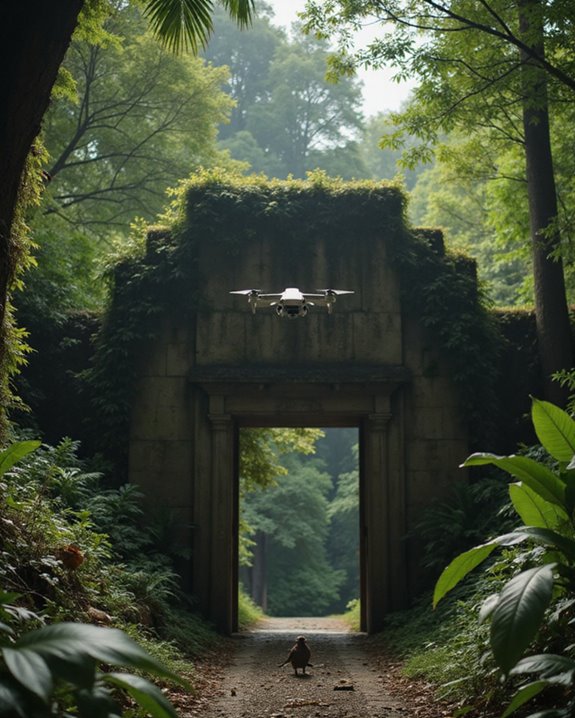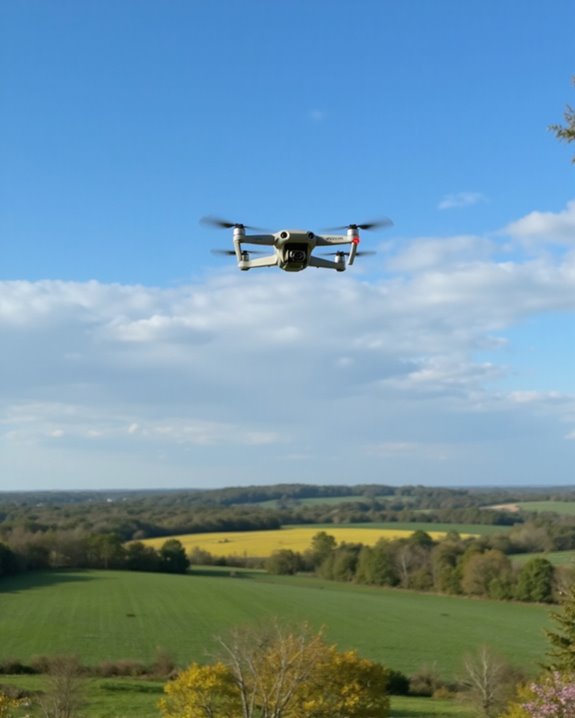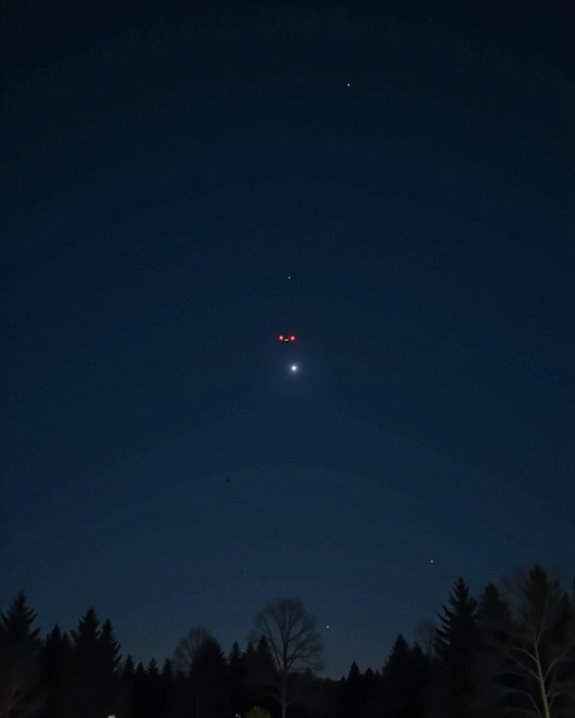Military drones excel in nighttime operations thanks to sophisticated technology. They’re equipped with thermal imaging sensors, infrared cameras, and advanced night vision systems that transform darkness into navigable terrain. Unlike civilian drones, military UAVs enjoy regulatory exemptions that allow them to conduct reconnaissance, surveillance, and combat missions after sunset. These nocturnal capabilities provide vital tactical advantages on the battlefield! The integration of AI with these sensor systems is creating even more formidable night operators in today’s modern conflicts.
Key Takeaways
- Military drones regularly operate at night using infrared technology, thermal imaging, and night vision cameras.
- Advanced sensor systems like EO/IR and thermal imaging with 640×512 resolution detect heat signatures in complete darkness.
- Stabilized gimbal systems ensure clear imagery during nighttime operations even in turbulent conditions.
- Military drones receive exemptions from standard restrictions that apply to civilian aircraft for nighttime operations.
- AI integration enhances nighttime capability through improved image processing and autonomous navigation in low-light environments.
The Evolution of Nighttime Drone Technology
While early military drones were limited to daytime operations, the evolution of nighttime drone technology has transformed modern warfare in remarkable ways! The Prototype History of these aerial marvels shows a fascinating progression from rudimentary military tools to sophisticated night-capable surveillance systems. Through distinct Advancement Phases, engineers integrated infrared technology and night vision cameras that allow drones to navigate and capture detailed imagery in complete darkness.
Remember when drones could only fly during sunny days? Not anymore! Today’s military drones utilize multiple sensors and advanced camera systems that transmit real-time data to ground stations, giving troops unprecedented situational awareness. These technological leaps have created significant operational advantages, enabling military personnel to gather vital intelligence without risking human lives in dangerous nighttime missions—pretty impressive for flying robots, wouldn’t you agree? Modern thermal drones, such as those with 640×512 thermal sensors, provide enhanced heat signature detection critical for night operations.
Military Night Vision Capabilities Explained
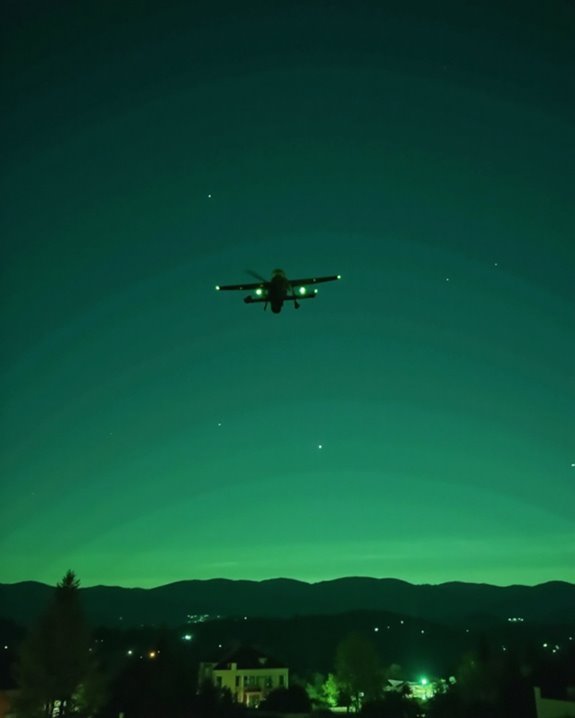
Night vision technology forms the backbone of modern military drone operations after dark! These systems employ multiple sensor types—thermal imaging detects heat signatures, infrared captures radiation invisible to human eyes, and low-light cameras amplify minimal ambient light. Training methods for drone operators emphasize mastering these complementary technologies, which often display as split-screen or fused imagery for enhanced situational awareness.
Most military drones feature stabilized gimbal mounts that maintain crisp visuals even during turbulent flight conditions—a game-changer when you’re trying to spot a target from thousands of feet up! The ethical implications of these capabilities remain complex, as the same technology that protects troops can raise privacy concerns when deployed. With multi-sensor payloads becoming increasingly sophisticated, today’s night-flying drones can practically turn midnight into midday for military operations! Advanced models also incorporate AI Night Shot technology to enhance after-dark imaging capabilities.
Key Sensor Technologies for Nocturnal Operations
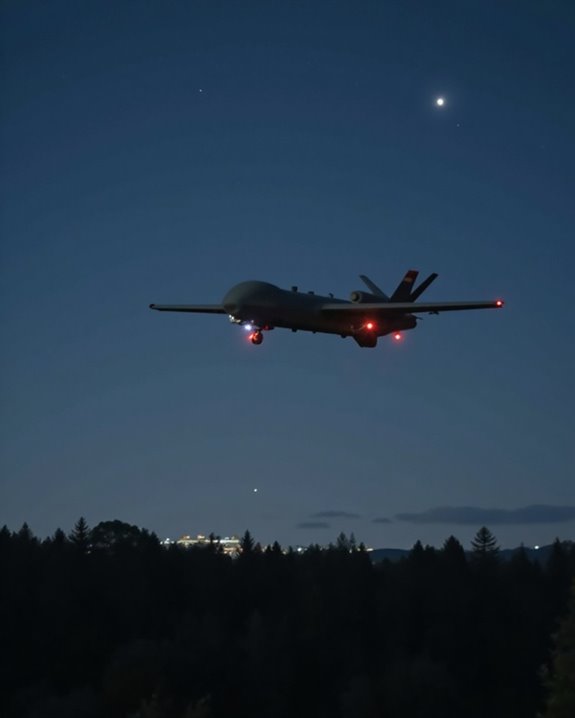
The backbone of every successful military night operation relies on an impressive array of specialized sensor technologies that transform darkness into a tactical advantage! Modern military drones employ EO/IR sensors that capture high-resolution imagery in both visible and infrared spectrums, making them effective 24/7 surveillance platforms.
Thermal imaging sensors detect heat signatures, allowing operators to spot targets that would otherwise remain hidden. Sensor Fusion plays a vital role by integrating multiple data streams from infrared cameras and wavelength detectors into a thorough tactical picture. Today’s Payload Design incorporates stabilized gimbal systems that guarantee crystal-clear images even when conditions get rough! Multispectral sensors distinguish between different materials—quite handy when you need to tell if that’s a vehicle or just a warm rock!
Additionally, many military drones feature advanced thermal resolution capabilities, such as 640×512 sensors, to provide detailed heat signature detection even in challenging environments.
Thermal Imaging: The Backbone of Night Missions
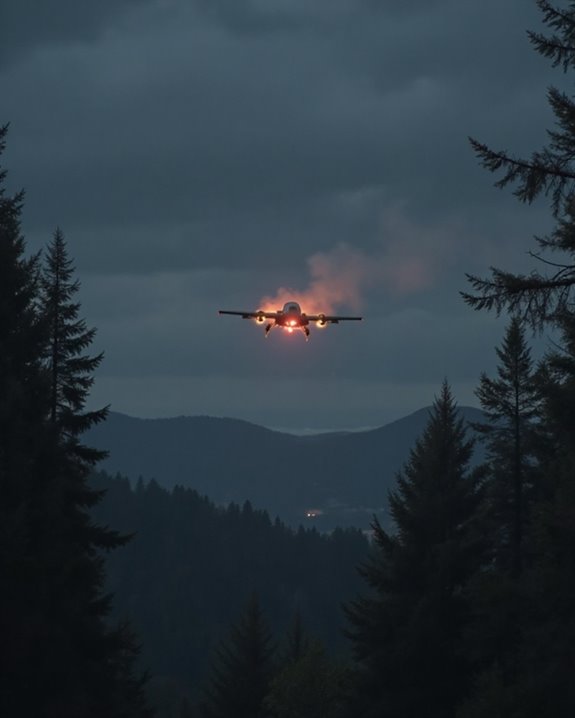
Among all the technologies that give military drones their nighttime capabilities, thermal imaging stands as the true powerhouse of nocturnal operations! This remarkable technology detects heat signatures from people and equipment, enabling drones to “see” through darkness, smoke, and fog with astonishing clarity.
Military strategists love thermal imaging because it transforms pitch-black forests and urban environments into navigable terrain for surveillance. Regular Calibration Techniques guarantee these systems maintain peak performance, even in challenging weather conditions. When combined with visual and radar sensors, thermal imaging creates a thorough detection system that leaves few places to hide!
Of course, this capability raises Ethical Concerns about privacy and potential misuse, as these eyes in the night sky can observe without being observed themselves. Still, for military operations where saving lives is paramount, thermal imaging remains indispensable.
Strategic Advantages of After-Dark Surveillance
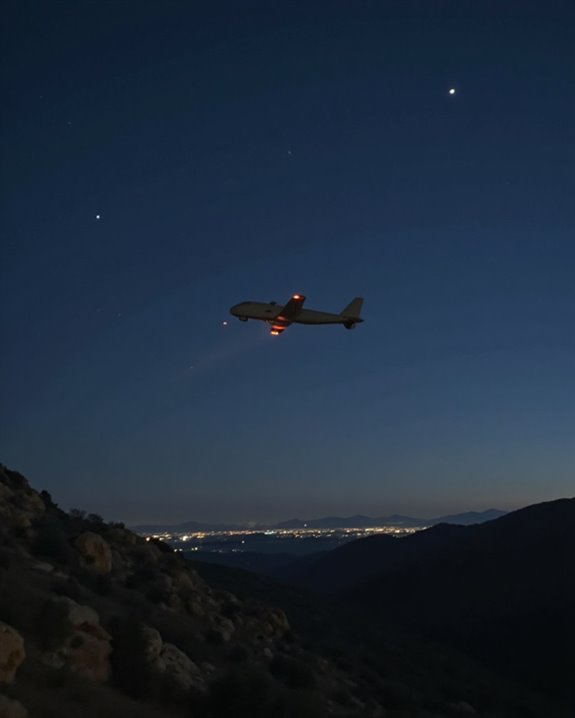
Darkness transforms the battlefield into an entirely different arena, one where military drones now reign supreme! Operating under the cover of night provides exceptional Deterrence Strategy, as adversaries can never truly know when they’re being watched. The continuous presence of these silent guardians, especially during vulnerable nighttime hours, dramatically reduces illicit activities along borders and near critical infrastructure.
The unmatched Flexibility Tactics of after-dark drone operations give military commanders options that weren’t possible before! By combining stealth, reduced detectability, and advanced night vision capabilities, drones can monitor vast areas without alerting hostile forces. This cost-effective approach not only saves resources but keeps personnel safely away from danger zones. Who needs to risk human lives when a drone can quietly zip through the darkness, collecting crucial intelligence while the enemy remains completely unaware?
Real-World Examples of Successful Night Operations
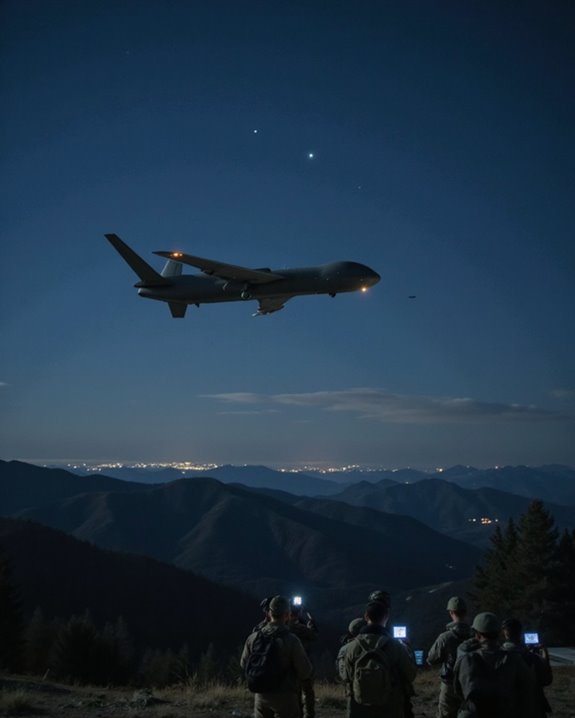
Across modern battlefields worldwide, military drones have revolutionized nighttime warfare with their remarkable success stories! Ukrainian forces have demonstrated this perfectly, using FPV drones like the Techno Taras to counter Russian UAVs in darkness. These operations showcase how night vision technology transforms Urban Engagements, allowing operators to monitor enemy movements without risking personnel.
Border Patrols have similarly benefited from nighttime drone surveillance, with tethered units providing continuous monitoring for hours. One compelling advantage? The elevated vantage points overcome line-of-sight limitations that plague ground forces in complex terrain. Military commanders now regularly deploy these systems for nighttime reconnaissance, searching for wounded soldiers, and delivering critical supplies—all while the enemy sleeps! The combination of infrared technology and compact design has truly made 24-hour battlefield awareness a reality.
Challenges and Limitations of Nighttime Drone Flights
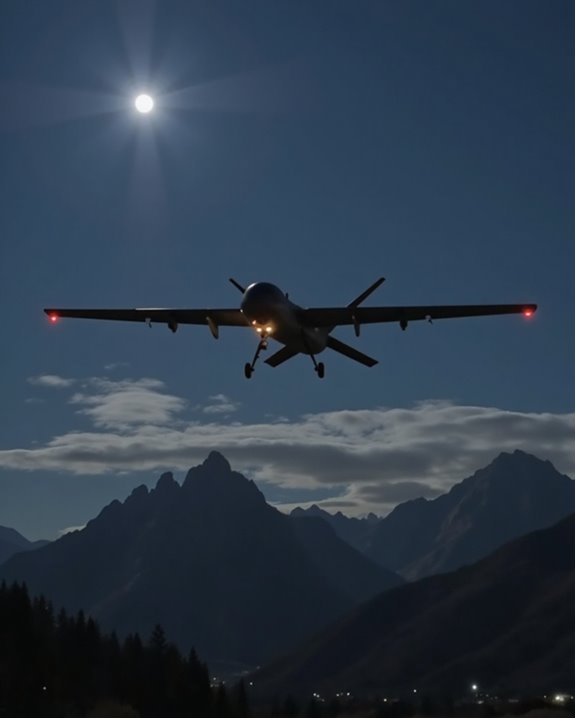
Despite the remarkable capabilities of military drones during nighttime operations, significant challenges emerge when pilots navigate the darkened skies! Visual line of sight becomes notoriously difficult to maintain, increasing the risk of losing track of these expensive assets. Cost barriers often limit which units can deploy advanced night vision systems, creating operational gaps across military branches.
Pilots struggle with obstacle detection and physiological illusions that distort perception, while environmental factors like fog compound these difficulties. The restricted field of view creates tactical blind spots, and GPS reliability issues can send drones off course. Ethical dilemmas also arise regarding surveillance capabilities that might capture unintended targets during darkness. The military’s solution? Specialized training programs and lighting solutions that balance visibility needs with mission secrecy – not an easy compromise when you’re trying to stay invisible!
Regulatory Framework for Military Night Operations
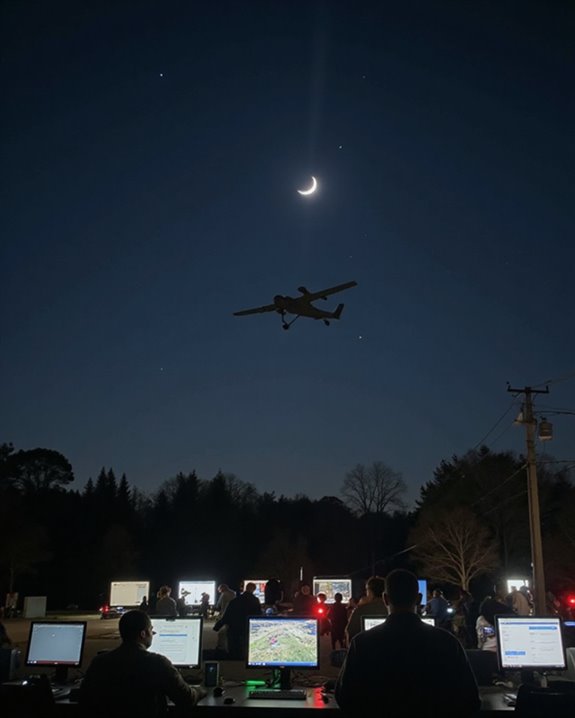
The regulatory framework governing military drone operations at night exists in a complex legal gray zone! While civilian drones must follow strict FAA guidelines, military unmanned aircraft benefit from significant exemptions that allow for enhanced operational flexibility. These Jurisdictional Limits create a separate regulatory environment where military drones can conduct nighttime missions without the same restrictions as their civilian counterparts.
Most fascinating is how Classification Protocols impact these regulations—many specific details about military night operations remain confidential! The military operates under specialized guidelines that permit advanced surveillance capabilities after dark, using infrared and night vision technologies that would be restricted in civilian contexts. This regulatory separation exists by design, allowing armed forces to maintain tactical advantages while conducting reconnaissance, intelligence gathering, and support operations when darkness falls.
The Future Landscape of Nocturnal Drone Warfare
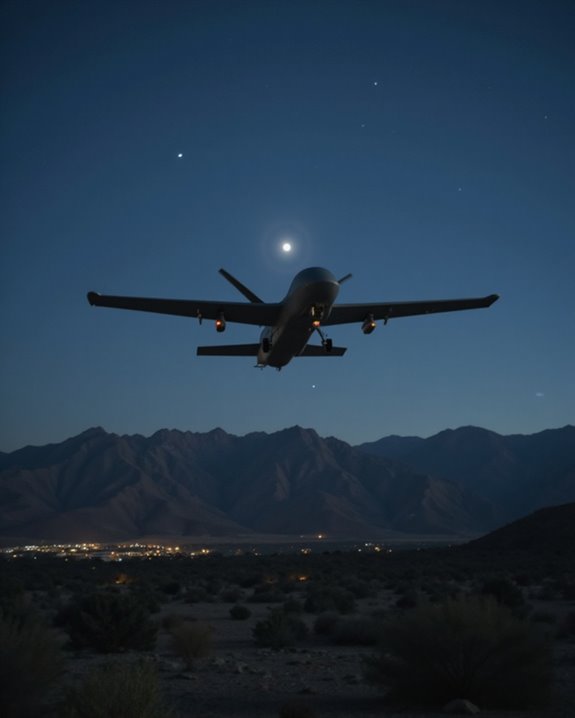
Looking beyond current regulatory frameworks reveals a fascinating glimpse into tomorrow’s nocturnal battlefield! The integration of AI with advanced sensors will transform how military Drone Alliances operate in darkness, enabling unprecedented coordination between unmanned systems and human operators.
Experts predict significant advancements in autonomous nighttime operations, with drones capable of making split-second tactical decisions while maintaining strict adherence to rules of engagement. The Ethical Implications of these developments cannot be overlooked, as increased automation raises questions about responsibility and oversight in combat situations.
Miniaturization trends will continue, with next-generation drones becoming smaller yet more capable, combining thermal imaging with enhanced AI processing! Integration with soldier wearables, like advanced night vision goggles, will create seamless human-machine teaming that extends warfighter capabilities far beyond current limitations. The future of night warfare is already taking flight!
Frequently Asked Questions
How Are Drone Operators Trained for Nighttime Missions?
Drone operators receive specialized night training methods covering visual illusions, physiological adaptations, and anti-collision lighting requirements. Programs include hands-on exercises, sensory techniques for low-light conditions, and scenario-based drills to guarantee operational effectiveness and safety.
What Is the Battery Life Impact During Night Operations?
Battery life during night operations experiences voltage drop due to cold temperatures, with capacity loss of 10-20%. Infrared sensors and night vision equipment also increase power consumption, further reducing operational flight times.
Can Military Drones Communicate With Each Other at Night?
Aye verily, military drones readily communicate with each other at night. Their night communication capabilities utilize encrypted data links and multilink technologies to overcome signal interference, while mesh networking enables collaborative operation through autonomous data relay and coordination.
How Do Adverse Weather Conditions Affect Nighttime Drone Effectiveness?
Adverse weather greatly reduces drone effectiveness at night. Fog limitations hamper sensor clarity and vision systems, while rain disruptions affect flight stability and electronic components. These conditions collectively degrade surveillance quality and operational reliability.
What Countermeasures Exist Against Enemy Nighttime Drone Surveillance?
Countermeasures against nighttime drone surveillance include RF jamming techniques to disrupt communications, stealth coatings to reduce infrared signatures, physical barriers, GPS spoofing, and decoy deployments that confuse enemy targeting and detection systems.


